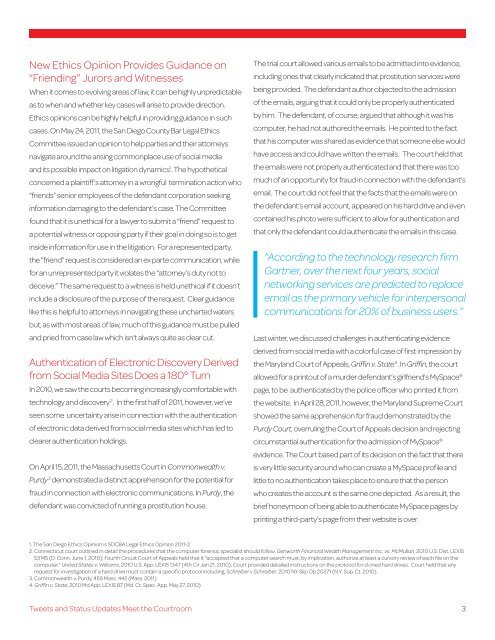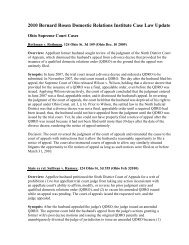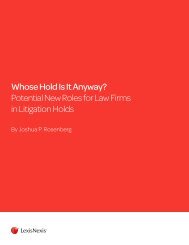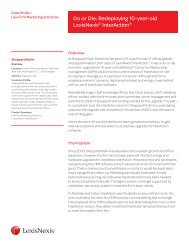Tweets and Status Updates Meet the Courtroom - Austin Bar ...
Tweets and Status Updates Meet the Courtroom - Austin Bar ...
Tweets and Status Updates Meet the Courtroom - Austin Bar ...
You also want an ePaper? Increase the reach of your titles
YUMPU automatically turns print PDFs into web optimized ePapers that Google loves.
New Ethics Opinion Provides Guidance on<br />
“Friending” Jurors <strong>and</strong> Witnesses<br />
When it comes to evolving areas of law, it can be highly unpredictable<br />
as to when <strong>and</strong> whe<strong>the</strong>r key cases will arise to provide direction.<br />
Ethics opinions can be highly helpful in providing guidance in such<br />
cases. On May 24, 2011, <strong>the</strong> San Diego County <strong>Bar</strong> Legal Ethics<br />
Committee issued an opinion to help parties <strong>and</strong> <strong>the</strong>ir attorneys<br />
navigate around <strong>the</strong> arising commonplace use of social media<br />
<strong>and</strong> its possible impact on litigation dynamics 1 . The hypo<strong>the</strong>tical<br />
concerned a plaintiff’s attorney in a wrongful termination action who<br />
“friends” senior employees of <strong>the</strong> defendant corporation seeking<br />
information damaging to <strong>the</strong> defendant’s case. The Committee<br />
found that it is unethical for a lawyer to submit a “friend” request to<br />
a potential witness or opposing party if <strong>the</strong>ir goal in doing so is to get<br />
inside information for use in <strong>the</strong> litigation. For a represented party,<br />
<strong>the</strong> “friend” request is considered an ex parte communication, while<br />
for an unrepresented party it violates <strong>the</strong> “attorney’s duty not to<br />
deceive.” The same request to a witness is held unethical if it doesn’t<br />
include a disclosure of <strong>the</strong> purpose of <strong>the</strong> request. Clear guidance<br />
like this is helpful to attorneys in navigating <strong>the</strong>se uncharted waters<br />
but, as with most areas of law, much of this guidance must be pulled<br />
<strong>and</strong> pried from case law which isn’t always quite as clear cut.<br />
Au<strong>the</strong>ntication of Electronic Discovery Derived<br />
from Social Media Sites Does a 180° Turn<br />
In 2010, we saw <strong>the</strong> courts becoming increasingly comfortable with<br />
technology <strong>and</strong> discovery 2 . In <strong>the</strong> first half of 2011, however, we’ve<br />
seen some uncertainty arise in connection with <strong>the</strong> au<strong>the</strong>ntication<br />
of electronic data derived from social media sites which has led to<br />
clearer au<strong>the</strong>ntication holdings.<br />
On April 15, 2011, <strong>the</strong> Massachusetts Court in Commonwealth v.<br />
Purdy 3 demonstrated a distinct apprehension for <strong>the</strong> potential for<br />
fraud in connection with electronic communications. In Purdy, <strong>the</strong><br />
defendant was convicted of running a prostitution house.<br />
The trial court allowed various emails to be admitted into evidence,<br />
including ones that clearly indicated that prostitution services were<br />
being provided. The defendant author objected to <strong>the</strong> admission<br />
of <strong>the</strong> emails, arguing that it could only be properly au<strong>the</strong>nticated<br />
by him. The defendant, of course, argued that although it was his<br />
computer, he had not authored <strong>the</strong> emails. He pointed to <strong>the</strong> fact<br />
that his computer was shared as evidence that someone else would<br />
have access <strong>and</strong> could have written <strong>the</strong> emails. The court held that<br />
<strong>the</strong> emails were not properly au<strong>the</strong>nticated <strong>and</strong> that <strong>the</strong>re was too<br />
much of an opportunity for fraud in connection with <strong>the</strong> defendant’s<br />
email. The court did not feel that <strong>the</strong> facts that <strong>the</strong> emails were on<br />
<strong>the</strong> defendant’s email account, appeared on his hard drive <strong>and</strong> even<br />
contained his photo were sufficient to allow for au<strong>the</strong>ntication <strong>and</strong><br />
that only <strong>the</strong> defendant could au<strong>the</strong>nticate <strong>the</strong> emails in this case.<br />
“According to <strong>the</strong> technology research firm<br />
Gartner, over <strong>the</strong> next four years, social<br />
networking services are predicted to replace<br />
email as <strong>the</strong> primary vehicle for interpersonal<br />
communications for 20% of business users.”<br />
Last winter, we discussed challenges in au<strong>the</strong>nticating evidence<br />
derived from social media with a colorful case of first impression by<br />
<strong>the</strong> Maryl<strong>and</strong> Court of Appeals, Griffin v. State 4 . In Griffin, <strong>the</strong> court<br />
allowed for a printout of a murder defendant’s girlfriend’s MySpace ®<br />
page, to be au<strong>the</strong>nticated by <strong>the</strong> police officer who printed it from<br />
<strong>the</strong> website. In April 28, 2011, however, <strong>the</strong> Maryl<strong>and</strong> Supreme Court<br />
showed <strong>the</strong> same apprehension for fraud demonstrated by <strong>the</strong><br />
Purdy Court, overruling <strong>the</strong> Court of Appeals decision <strong>and</strong> rejecting<br />
circumstantial au<strong>the</strong>ntication for <strong>the</strong> admission of MySpace ®<br />
evidence. The Court based part of its decision on <strong>the</strong> fact that <strong>the</strong>re<br />
is very little security around who can create a MySpace profile <strong>and</strong><br />
little to no au<strong>the</strong>ntication takes place to ensure that <strong>the</strong> person<br />
who creates <strong>the</strong> account is <strong>the</strong> same one depicted. As a result, <strong>the</strong><br />
brief honeymoon of being able to au<strong>the</strong>nticate MySpace pages by<br />
printing a third-party’s page from <strong>the</strong>ir website is over.<br />
1. The San Diego Ethics Opinion is SDCBA Legal Ethics Opinion 2011-2<br />
2. Connecticut court outlined in detail <strong>the</strong> procedures that <strong>the</strong> computer forensic specialist should follow. Genworth Financial Wealth Management Inc. vs. McMullan, 2010 U.S. Dist. LEXIS<br />
53145 (D. Conn. June 1, 2010); Fourth Circuit Court of Appeals held that it “accepted that a computer search must, by implication, authorize at least a cursory review of each file on <strong>the</strong><br />
computer,” United States v. Williams, 2010 U.S. App. LEXIS 1347 (4th Cir Jan 21, 2010); Court provided detailed instructions on <strong>the</strong> protocol for cloned hard drives. Court held that any<br />
request for investigation of a hard drive must contain a specific protocol including, Schreiber v Schreiber, 2010 NY Slip Op 20271 (N.Y. Sup. Ct. 2010).<br />
3. Commonwealth v. Purdy, 459 Mass. 442 (Mass. 2011)<br />
4. Griffin v. State, 2010 Md App. LEXIS 87 (Md. Ct. Spec. App. May 27, 2010)<br />
<strong>Tweets</strong> <strong>and</strong> <strong>Status</strong> <strong>Updates</strong> <strong>Meet</strong> <strong>the</strong> <strong>Courtroom</strong> 3





